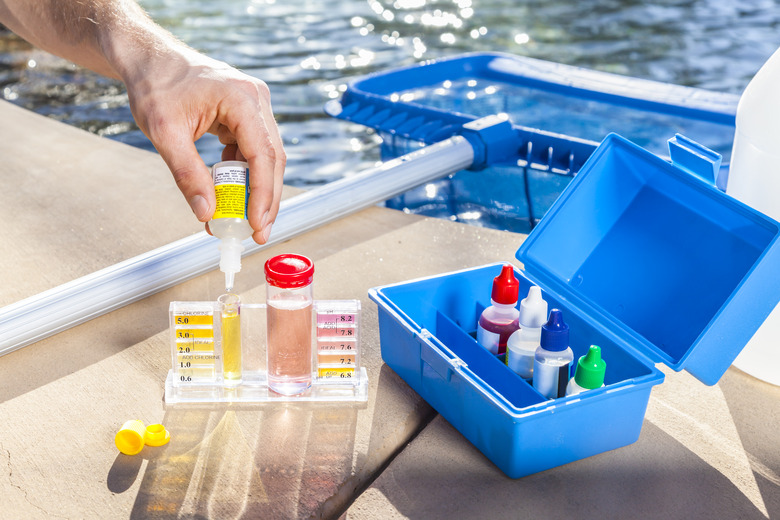How To Get Rid Of Purple Stains In A Swimming Pool
We may receive a commission on purchases made from links.
One of the prettiest problems you can have with your swimming pool is purple stains. Many pool owners find lovely lavender crystals hanging on their pool walls and equipment when they open their pool in the spring. The cause is a chemical known as cyanuric acid (CYA).
Cyanuric acid forms when high chlorine levels react with copper in the pool water. Even the most diligent scrubbing and cleaning won't solve the problem. Instead, you need to treat the pool chemically and then allow the CYA crystals to dissolve back into the water over time.
Treat the Right Problem
Treat the Right Problem
When you see purple crystals staining your pool. it's important to understand what does and does not cause them so you can treat the correct problem. A popular myth that refuses to die is that purple stains indicate algae. This is not the case. Ironically, it's often low-quality algicides that cause CYA by adding copper to the pool water. As such, treating for algae won't help you get rid of a CYA problem.
People also frequently confuse a CYA problem with a manganese problem. Manganese does create a purple problem, but manganese turns the water itself purple. To fix a manganese problem, you'll need to super chlorinate your pool and then vacuum out the manganese particles when they settle on the bottom of the pool.
Drop Your CYA Level Quickly
Drop Your CYA Level Quickly
In the aquarium industry, fish keepers often say that dilution is the solution. This same mantra can help you fix a high level of CYA. If you drain your pool about halfway and then refill it, you've automatically halved your CYA levels. This assumes, of course, that your water source doesn't contain copper.
After refilling the pool, allow the water to circulate for 48 hours. You'll then want to check your CYA levels. Ideally, they should now be between 40 and 50 ppm. If they aren't, add a CYA reducing agent from your local pool supply store as directed on the product label.
Manage the pH
Manage the pH
When you've gotten your CYA levels where you want them, help keep them there by adjusting your pH and total alkalinity levels. You want your pH level between 7.4 and 7.6. Aim for a total alkalinity of 80 to 140 ppm. A pH level over 7.8, a total alkalinity over 150 ppm, and a CYA level over 100 ppm will all contribute to a CYA staining problem, so always keep these numbers in check.
Once your pool is properly treated and balanced, your task is to keep it that way. If you do, the CYA stains will eventually dissolve on their own. This process can easily take four weeks. It is safe to swim in the pool during this time.
Fix Ongoing Copper Issues
Fix Ongoing Copper Issues
CYA stains in your pool might be a one-time issue caused by a cheap algicide. If you suspect this is the problem, use higher-quality algicides in the future. It's possible, however, that there is copper in your supply water or that there are copper pipe fittings in your plumbing. In this case, you'll need to treat your pool for copper on an ongoing basis.
To do so, treat your pool with a metal sequestering agent. This treatment is generally required about once a week, but you can test your pool water to make sure that timeline works for you. Your aim is to keep any copper in your pool water below 0.5 ppm.
